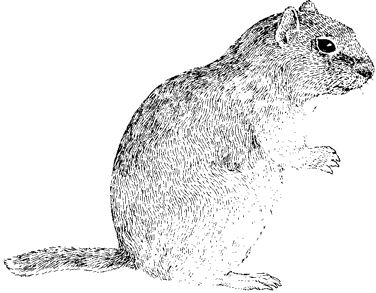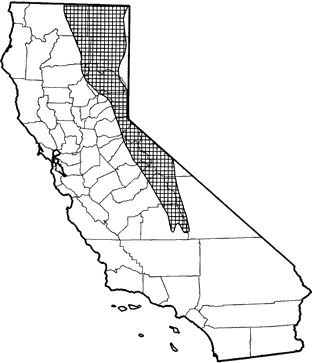
Belding's Ground Squirrel
Distribution, Abundance, and Seasonality
Belding's ground squirrel is common in its California range, which extends along the Sierra Nevada from Tulare and Inyo cos. north to the Oregon border. Optimal habitats are alpine dwarf-shrub, wet meadow, perennial and annual grassland, and open, grassy stands of bitterbrush and sagebrush. Also found in open stands of many wooded and chaparral habitats with grassy understories. Varying numbers may invade croplands and pastures. This species ranges from 1500-3000 m (4900-9800 ft) in elevation on the east side of the Sierra Nevada, and from high elevations down to 1900 m (6000 ft) on the west side (Grinnell and Dixon 1919, Hall 1946, Ingles 1965, Turner 1972, Jenkins and Eshelman 1984).

Range Map
Specific Habitat Requirements
Feeding: This herbivore feeds on a variety of grasses and forbs, eating leaves, stems, seeds, bulbs, and fruits. Also eats some insects, and occasionally may be cannibalistic. Forages on the ground surface. Does not store food, but accumulates body fat, doubling body weight prior to hibernation (Morhardt and Gates 1974).
Cover: Retreats to burrow to avoid predators (Sherman 1977).
Reproduction: Burrows are dug in loose soil, often near water and patches of bunchgrass, frequently in open areas with little cover (Grinnell and Dixon 1919, Hall 1946). Females dig burrows 3-4.5 m (10-15 ft) long and 0.3-0.6 m (1-2 ft) deep, with at least two openings, and build grass nests inside (Whitaker 1980).
Water: Uses evaporative cooling and convection to avoid heat stress. Distribution is tied to water, suggesting that water is perhaps the most important limiting factor. Gets water from food and from drinking.
Pattern: Prefers open areas with short grasses and little canopy. Prefers friable soils for burrowing, but may use adjoining rocky and woody areas for feeding. Belding's ground squirrel usually is found close to a source of water.
Species Life History
Activity Patterns: Diurnal; hibernates up to 8 mo of the year. Hibernation begins in July through September, depending on elevation, and terminates from March through May. Males enter hibernation first, followed by females, then young of the year. Males emerge first, females emerge from April to June (Loehr and Risser 1977). At Tioga Pass, timing of first emergence varies up to 6 wk; emergence is earlier in years of light snowpack. Late spring snowstorms suspend mating and may cause heavy mortality, especially among females (Morton and Sherman 1978).
Seasonal Movements / Migration: None.
Home Range: At Tioga Pass, home ranges averaged 0.6 ha (1.5 ac) for males, and slightly smaller for females (Morton et al. 1974). According to Grinnell and Dixon (1919), these squirrels range only "a few yards" from their burrows. Densities of 32 per ha (15 per ac) have been reported.
Territory: Females share territory with related females, chasing others away from burrows. Males fight for access to receptive females.
Reproduction: Mating occurs soon after emergence from hibernation. Females typically mate with several males (Hanken and Sherman 1981). After a gestation period of 28 days, the young are born in mid-May to mid-July (Morton and Gallup 1975). Litter size averages 7 (ranging from 3-12). Mean litter size of first-yr females was less than that of second-yr females; few third-yr females bred, but those that did had a mean close to that of second-yr females (Costain and Verts 1982). Juvenile males disperse out of their mother's home range, but some juvenile females do not; thus, old females tend to be surrounded by related females. A female that has lost her young to predators may take over a safer site, killing any young at that site. Males may also be cannibalistic, killing unrelated young ground squirrels.
Niche: Tends to occur in large, semicolonial populations. Predators include coyotes, bears, badgers, weasels, foxes, hawks, and eagles. However, the chief cause of death is weather: 54-93% of juveniles, and 23-68% of adults, perish during hibernation, and more may die in late spring snowstorms (Morton and Sherman 1978). Carries fleas that may harbor sylvatic plague (Ingles 1965).
Sources & References
California Department of Fish and Game, 1999.
California's Wildlife, Sacramento, CA.
Written by: V. Johnson, reviewed by: H. Shellhammer, edited by: J. Harris, S. Granholm
Costain, D. B., and B. J. Verts. 1982. Age determination and age-specific reproduction in Belding's ground squirrels (Spermophilus beldingi). Northwest Sci. 56:230-235. French, A. R. 1982. Intraspecific differences in the pattern of hibernation in the ground squirrel Spermophilus beldingi. J. Comp. Physiol. Biochem. B148:83-92. Grinnell, J., and J. Dixon. 1919. Natural history of the ground squirrels of California. Calif. State Comm. Horticulture Bull. 7:597-708. Hall, E. R. 1946. Mammals of Nevada. Univ. California Press, Berkeley. 710pp. Hanken, J., and P. W. Sherman. 1981. Multiple paternity in Belding's ground squirrel (Spermophilus belding) litters. Science 212:351-353. Ingles, L. G. 1965. Mammals of the Pacific states. Stanford Univ. Press, Stanford, CA. 506pp. Jenkins, S. H., and B. D. Eshelman. 1984. Spermophilus beldingi. Mammal. Species No. 221. 8pp. Loehr, K. A., and A. C. Risser, Jr. 1977. Daily and seasonal activity patterns of the Belding ground squirrel in the Sierra Nevada. J. Mammal. 58:445-448. Morhardt, S. S., and D. M. Gates. 1974. Energy exchange analysis of the Belding ground squirrel and its habitat. Ecol. Monogr. 44:17-44. Morton, M. L., and J. S. Gallup. 1975. Reproductive cycle of the Belding ground squirrel (Spermophilus beldingi beldingi): seasonal and age differences. Great Basin Nat. 35:427-433. Morton, M. L., C. S. Maxwell, and C. E. Wade. 1974. Body size, body composition, and behavior of juvenile Belding ground squirrels. Great Basin. Nat. 34:121-134. Morton, M. L., and P. W. Sherman. 1978. Effects of a spring snowstorm on behavior, reproduction, and survival of Belding's ground squirrels. Can. J. Zool. 56:2578-2590. Robinson, S. R. 1980. Antipredator behavior and predator recognition in Belding's ground squirrels (Spermophilus beldingi). Anim. Behav. 28:840-852. Sauer, W. C. 1976. Control of the Oregon ground squirrel (Spermophilus beldingi oregonus). Vertebr. Pest Control Conf. Proc. 7:99-109. Sherman, P. W. 1977. Nepotism and the evolution of alarm calls. Science 197:1246-1253. Turner, L. W. 1972. Habitat differences between Spermophilus beldingi and Spermophilus columbianus in Oregon. J. Mammal. 53:914-917. Whitaker, J. O., Jr. 1980. The Audubon Society field guide to North American mammals. A. Knopf, New York. 745pp.
California Animal Facts | California's Wildlife